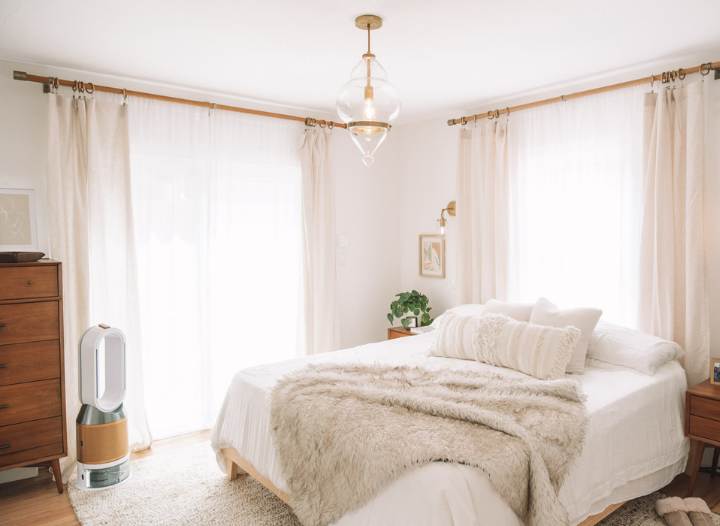The last time we came to Lundy was by ferry from Ilfracombe. The journey took two hours and once we rounded Hartland Point the Atlantic waves rolled in and about 50% of the passengers started vomiting.
This time the MS Oldenburg is in for annual maintenance, so me and a group of six friends are whisked to the island in a small helicopter from the north-western tip of Devon in seven minutes. I don’t miss the vomiting, but I regret not having the sense of temporal acclimatisation to what has been, for much of its history, a slightly different world.
Lundy, three miles long and about half a mile wide, is at the border of the Bristol Channel and the Atlantic. In Welsh mythology it is one of the gateways to Annwn, the otherworldly realm also known as Avalon. Eleven miles off the Devon coast and often obscured by fog, it has tugged on mainlanders’ imaginations for centuries. Its history can be summed up as a succession of eccentrics, ranging from the murderous to the more benign, trying to build little empires here.
The island’s geography – dramatically twisted granite cliffs reaching over 100 metres high – lends itself to a sense of impregnability. There is just one landing point, near a rocky bay called the Devil’s Kitchen. In the early 1600s, Moroccan pirates used Lundy as a base from which to raid West Country ports. A century later, a tobacco smuggler and duplicitous MP called Thomas Benson imported convicts here from the mainland to use as his private slaves.
In 1836 the island was bought by William Hudson Heaven with the money he had received as compensation for the emancipation of enslaved people on his plantation in Jamaica. Ironically, given that history, he declared it a “free island”. He also built an outsize Anglican church and quarried granite from the cliffs. Lundy was jokingly dubbed the Kingdom of Heaven.
A later owner, Martin Coles Harman, also styled himself a king, and was prosecuted for issuing his own currency, in the form of Half Puffin and One Puffin coins. Finally, in 1969, Lundy was donated to the National Trust. The solid granite cottages that comprise its one village were restored by the Landmark Trust, which still manages them now, and the island’s “permanent” population – currently 28 – is largely employed in servicing these properties for visitors like us.
Most people come to Lundy on a day trip, but we opt to stay for five nights. This may seem a long time on a three-mile rock, but the island is a world in itself; soon its solitude and wildness feel hard to leave, the mainland ever more distant.
after newsletter promotion
There are 25 properties to choose from, ranging from the remote, off-grid Tibbetts to the former keepers’ quarters in the old lighthouse. There is also a bunkhouse and a campsite for warmer weather. We stay in Old House South, which used to form part of a manor. It is cosy yet elegant, with beautiful rugs, a wood-burning stove and shelves full of well-thumbed books. We cook most of our meals here – the village shop is well supplied – but treat ourselves to a few pub meals in the Marisco Tavern next door.
The tavern is the point around which Lundy’s (human) life revolves. Its walls are hung with lifebelts from the many ships wrecked on its shores: Taxiarchis, Maria Kyriakides, Kaaksburg, Blue Merlin. It is also a community centre and information hub, and several times a week head warden Joe Parker gives a free talk about the island’s ecology. Apart from its wild human history, what makes Lundy extraordinary is its wild nature.
In 2010 Lundy became the UK’s first marine conservation zone, with its eastern seaboard protected from all forms of fishing. It has a resident population of 180 Atlantic grey seals, which often gather around the jetty where the Oldenburg comes in – and dolphins, porpoises, basking sharks and even occasional minke whales are visitors to its waters. The seas here mark the northern range of rare cold water corals, including the pink sea fan, which can grow to half a metre tall. The island’s cliffs are important breeding grounds for up to 40,000 globally endangered seabirds.
In his talk, Joe tells us things have not always been this way. Two decades ago, Lundy was overrun with black and brown rats, whose voracious egg-eating habits devastated the seabird population. The island is famous for its puffins – Lund-ey is Old Norse for Puffin Island – but in 2001 only five individuals were recorded here and the species was at risk of extirpation. Manx shearwaters, which migrate from the tip of South America, were also endangered, as were gannets, kittiwakes, guillemots, razorbills and fulmars. Culling the rats was controversial, but it was either the birds or them. After an eradication campaign, the island was declared rat-free in 2006.
The seabird population increase has been dramatic. In 2023, puffin numbers were up from five to 1,335, and shearwaters from 297 breeding pairs to more than 12,000. Much of the island is protected as a Site of Special Scientific Interest; it is also home to pygmy shrews, more than 500 species of fungi, and the endemic Lundy cabbage. However, Joe and others are agitating for Special Protection Area (SPA) status to safeguard the seabirds’ foraging grounds and flyways. This, he says, is essential for their long-term preservation. In the meantime, wardens and rangers regularly patrol the cliffs, checking bait stations for signs of rodent recolonisation. Rats who have stowed away on ships can swim for a couple of miles, so Lundy can never let down its guard but, for now, the puffins lay their eggs in peace.
They are preparing to do just that when we see them at Jenny’s Cove, through a clifftop telescope set up by a volunteer. At first the birds look like bright white stones scattered down a grassy slope, but when the lens focuses they leap into sharp relief. It is early April, so these are among the first breeding pairs to have arrived in the British Isles; after July they will be gone, back to the open Atlantic. Awareness of how close they came to vanishing only adds to the pleasure, and privilege, of watching them – so much smaller than we’d imagined, but inexpressibly delightful.
It’s a stormy day, with blasts of wind that almost knock us off our feet. Despite the weather we have ventured north as far as Halfway Wall, one of the three drystone walls that divide the island. South of Quarter Wall lies the human realm of tavern and church, which already feels a world away. North of Threequarter Wall are cliffs and crashing waves. Here and there, huddled against the wind, are Highland cows, Lundy ponies, Sika deer and Soay sheep, all have been introduced in the past 100 years. They do much less harm than rats, though there are still too many of them: Joe is vegan on the mainland but eats lamb and venison here, “organic, totally free range, and no air miles”. The Soay breed comes from St Kilda in the Outer Hebrides, and is the closest surviving thing to sheep from the Neolithic age. Humans arrived on Lundy at least 10,000 years ago, so it is not impossible that those first inhabitants kept hardy flocks similar to the ones that roam today.
The peculiar magic of this island lies in the way it blends sociability with solitude. Conversation is easy in the tavern, and people’s shared isolation gives them a sense of comradeship. No wonder visitors return, and the year-round residents – wardens, housekeepers, bar staff – stay for an average of five years. It takes a certain type. And yet, despite the permanence of the granite cliffs and cottages, everyone leaves in the end, as they always have. Mariscos, Heavens and Harmans stuck it out for decades, but they all vanished too, like extirpated seabirds. Only nature is permanent here, and even that – just ask the puffins – is vulnerable. Lundy’s designation as an SPA may just make the difference.
Accommodation on Lundy starts from £276 for four nights for two people in Castle Keep North; camping from £48pp. Day trips by ferry cost £52 adults, £27 children (4-15), under 4s free






